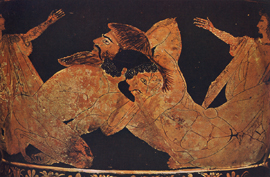Attic red-figure
Euphronios's 'Antaios crater'
Museum: Paris, Louvre
Size: 46cm high, 55cm diameter (calyx-crater)
Function: convivial
Technique: red-figure (relief dots, relief lines, black and brown lines and washes of dilute brown)
Style: Pioneer
Subject/s: A. Herakles wrestles with the Libyan giant Antaios – a tale celebrated by the poet Pindar and tragedian Phrynichos, Euphronios contemporary. The neatly-coiffed Greek grapples with the shaggy-haired giant; both are nude to reveal the surface anatomy of the body. Herakless profile pose is reminiscent of his earlier encounter with the lion of Nemea (whose skin hangs on the far left), but Antaioss has been turned towards us so that we can see the trunks musculature. The near leg is sharply flexed, the thigh in full frontal view and the lower leg receding; the sole of the foot is visible. B. a pipes player steps on to a base inscribed Melas is handsome (kalos).
Date: late 6th c.
Analysis: a large and 'new' (introduced by Exekias) shape, well made and finely painted suggests a special piece, as does the Euphronioss signature as painter and the usual subjects. The attention focused on the rendering of Antaioss body is remarkable. The 'Pioneer style takes its name from this new interest in the bodys surface anatomy and the potential for rendering movement in space – an interest probably stimulated by contemporary developments in Greek science.







